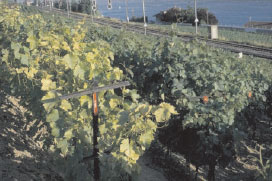Plant Factors
The two strategies for iron acquisition under iron deficiency stress are separated along taxonomic lines, with grasses (Gramineae, Poaceae) showing Strategy 2, and other plant families and orders, including some closely related to the grasses such as the Restionales, Eriocaules, Commelinales, and Juncales, showing Strategy 1 (13).Iron deficiency does not occur in perennial woody plants such as grapevine or pear (Pyrus communis L.) grown on noncalcareous soils. For some plants such as sunflower, deficiency is uncommon even on calcareous soils. (In experiments in which sunflower has been used to examine the effects of iron deficiency, this effect has been achieved at conditions severely inhibiting iron acquisition, for example, by elevated bicarbonate concentrations.) In general, Strategy 1 plants show considerable sensitivity in their response to high bicarbonate and high soil pH, high soil moisture and poor aeration, high soil organic matter in calcareous soils, high concentrations of heavy metals, high ionic strength of the soil solution, and low soil temperature (13). In contrast, Strategy 2 plants have a lower sensitivity to these factors but a high sensitivity to high soil phosphate. Furthermore, high microbial activity in the rhizosphere can be deleterious due to a fast degradation of the released phytosiderophores (96,97).
The very term 'Fe-efficient' implies that the mechanisms of Strategy 1 and Strategy 2 for iron acquisition succeed in making sufficient iron available to plants for normal growth, and this result is indeed the case, particularly for Strategy 2 plants. For sunflower grown in calcareous soil, there is a rhythmic response to the low concentrations of available iron that is matched by a rhythmic uptake of iron (98). Calcicole plants growing in the wild are able to take up sufficient iron for normal growth, although it is probably adaptation to cope with the low availability of phosphorus that is more important in determining their ability to grow.
 |
| FIGURE 11.9 Differences in chlorosis resistance of grapevines (Vitis vinifera L.) on different root stocks (left, 5BB; right, Fercal). |
The whole concept of iron-efficient and iron-inefficient species raises the prospect of breeding for efficient acquisition of iron, and the level of knowledge about the genetics of the responses to onset of iron deficiency stress is making this improvement a distinct possibility. It has already been demonstrated that plants such as grapevines can be grown on iron-efficient rootstocks (Figure 11.9). Resistance to chorosis may be brought about by engineering crops with increased iron acquisition capability in a number of ways. For example, transgenic rice with a genomic fragment containing HvNAAT-A and HvNAAT-B from barley exhibited enhanced release of phytosiderophores and increased tolerance to low iron availability through the speeding up of a rate-limiting step of phytosiderophore biosynthesis (99). These plants had four times higher grain yield in alkaline soils than unmodified plants. The process of phytosiderophore release can also be crucial for iron acquisition (100), and this step could also be improved. In Strategy 1 Arabidopsis thaliana, increased iron acquisition has been achieved by overexpressing the FRO2 Fe(III) chelate reductase (61). Additionally, plants could be engineered to contain higher concentrations of nicotianamine (92).
In addition to increasing the efficiency of iron acquisition, it may be possible to increase the concentrations of iron in harvested crop plants for human nutrition. Much of the world suffers from iron deficiency in the diet, and breeding crops such as 'golden rice,' which has a higher iron concentration as well as more vitamin A precursors, would be of considerable benefit to human welfare (101,102). In wheat, it may be possible to breed from accessions of wild wheat ancestors, such as Triticum turgidum subsp. dicoccoides, which contain higher concentrations of iron in their seeds than Triticum aestivum, to improve the nutritional quality of human and livestock feedstuffs (103).




